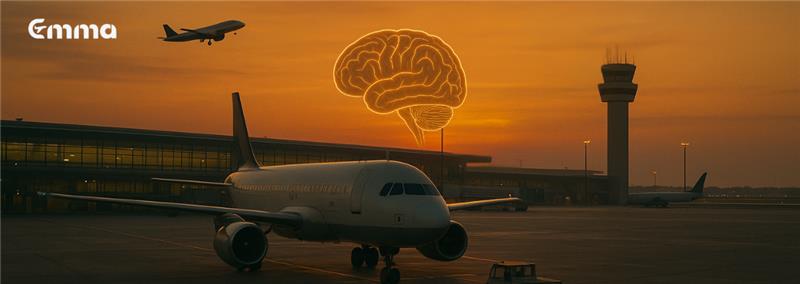
When we travel, especially through airports, there’s often a sense of disconnection, as though each part of the process is a disjointed puzzle rather than an integrated experience. I’ve always wondered: what if airports could work more like LEGO? Imagine if all the building blocks fit together perfectly, forming a cohesive, efficient, and stress-free travel journey.
Let’s think about it for a moment. What if an airport was designed to truly serve the traveler, using all the modern technology we already have at our fingertips? It could change the way we experience air travel, making it smoother, less stressful, and even enjoyable.
The Pain Points: Why Airports too often Feel Like Chaos
Most travelers know the drill: you arrive at the airport way earlier than necessary to avoid the dreaded rush or last-minute delays. You navigate through parking lots, long check-in lines, security checks, and confusing terminal layouts. Each part feels like a separate task, disconnected from the next. But why does it have to be this way?
Every airport has its distinct structure, but what if they were all interconnected, like LEGO bricks? They would fit perfectly into a seamless experience for travelers. You could know exactly where to park, if there’s parking available, or better yet, eliminate parking altogether by using an optimized ride-hailing system. Instead of lugging your bags through the airport, why not send your luggage ahead with a parcel delivery service? That way, you bypass check-in entirely.
A Glimpse into the Future: How Airports Could Work
The possibilities for streamlining air travel are endless, and the tools already exist. Let’s dream about what the ultimate LEGO-like airport experience could look like:
1. Automated Identification and Security Checks:
Forget about rummaging through your bags to pull out your passport or boarding pass. With facial recognition and biometric systems already in use at airports like Singapore Changi and Atlanta’s Hartsfield-Jackson, imagine if you could just walk through security checkpoints without ever showing a document. Your identity would be verified automatically using advanced scanners. You wouldn’t even need to pause.
2. Real-Time Information Flow:
One of the most stressful parts of air travel is the unknown—will my flight be delayed? Is my gate changed? What if, instead of scrambling for this information at the last minute, you received real-time updates on your phone as soon as changes occurred? Airports like Heathrow have already implemented real-time passenger information systems, but this could be expanded globally, informing passengers ahead of time to make better choices.
3. Pre-Booked Parking and Transparent Flows:
If you’re driving to the airport, knowing ahead of time where to park or whether parking is available would save a lot of time and frustration. Major airports could easily integrate an app that allows you to book a parking spot in advance and guides you directly to it.
4. Parcel Delivery for Luggage:
What if instead of carrying your bags through the airport, you could use a parcel service to send your luggage ahead of time? Companies like AirPortr already offer luggage delivery services, and some travelers have taken advantage of this to skip the entire check-in process. Scaling this service across airports globally could ease congestion at check-in and security.
5. More Time for Enjoyment and Productivity:
With all this automation, think of the time saved. You’d spend more time enjoying coffee shops, browsing duty-free stores, or simply relaxing, rather than waiting in line or stressing about delays. Travelers would be happier, which means they’d likely spend more money at shops and restaurants, boosting airport revenue.
So Why Aren’t Airports Fully Embracing This?
The technology for these changes already exists. We see self-service kiosks, facial recognition, mobile boarding passes, and real-time updates in airports worldwide, but they are rarely integrated to form a seamless whole. What’s holding airports back?
Airports operate with multiple stakeholders—airlines, security, ground handling services, and government bodies, each with its own priorities and control over parts of the traveler’s journey. Silos exist, preventing a truly unified experience for passengers. It’s like trying to build a LEGO structure without agreeing on how the pieces should fit together.
International organizations like ACI (Airports Council International) and IATA (International Air Transport Association) are working to set industry standards and encourage collaboration, but real change is slow. Many airports still operate like closed fortresses, resistant to change, with each stakeholder reluctant to lose control over “their domain.” But the future of air travel demands openness, transparency, and collaboration.
Time for Change: The Call to Action
What if we could take the plunge and make the future happen now? With all the tools in place, airports around the world could work together to streamline processes, increase collaboration, and create a truly traveler-first experience. The productivity gains would be enormous—not just for travelers, but for everyone involved in airport operations. Fewer traffic jams, reduced stress for security officers and ground handlers, and more time spent at shops and restaurants would benefit both the airport’s bottom line and travelers’ experiences.
Happier travelers consume more, spend more, and boost the economy. So, to all the stakeholders—airports, airlines, security agencies, and international bodies like ACI and IATA—the time to act is now. By making the traveler’s journey smoother, airports can unlock greater productivity and profitability.
It’s time for airports to work more like LEGO—perfectly connected, seamless, and smart.



